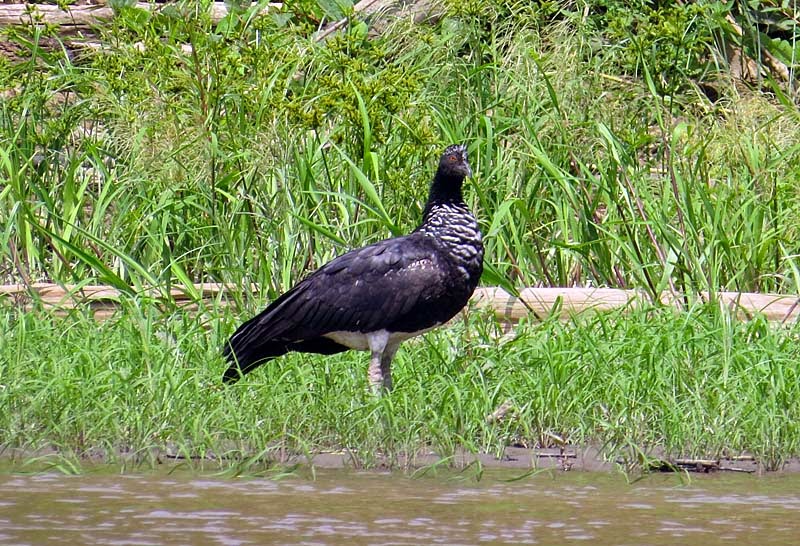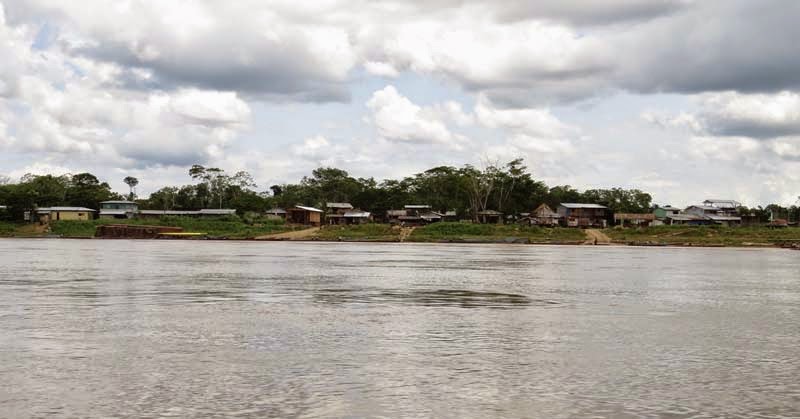This is the 10th in a series of blogs
covering a private tour I led down the Kosñipata Road and the Madre
de Dios River in SE Peru from October 25-November 7. Today was a
travel day – eight and a half hours of motoring down the Upper
Madre de Dios then the main Madre de Dios rivers to Los Amigos
Biological Station. So as to avoid any possibility of arriving after
dark, we departed Pantiacolla at 6:00 a.m., and all went without a
hitch.
The Pantiacolla Lodge grounds are a
reasonably sized clearing in the rain forest, and one can actually
see quite a bit from here. We were both wishing we had more time
here.
The Japanese film crew I mentioned in
my last blog were chasing after some very noisy Brown Titis (more on
that monkey in an upcoming blog), while in the meantime I spotted
these Venezuelan Red Howlers nearby.
Our last new bird here was this
cooperative Red-throated Caracara.
Forty minutes into our ride we could
look back and see Pantiacolla Ridge fading away. The next significant
mountain ridges to the east of here are 2000 miles away in eastern
Brazil.
We were always on the lookout for
interesting birds and animals along the way; a jaguar or giant
anteater is always possible, but we had to do with birds on this
trip. We had great views of a pair of Orinoco Geese on one island,
for example.
We made a quick potty stop on one young
river island, and I picked up this grasshopper, a typical spur-throat
(a huge subfamily, so I have no idea what species it is).
Farther downstream was this Horned
Screamer on the main bank. Screamers are a small family of very weird
birds. They are in the same order as geese and ducks so technically
qualify as waterfowl, but the three species (all restricted to South
America) don't even remind one of any kind of dabbler, diver, or
honker. None of them scream, either. This one pipes and honks in a
way that invariably elicits laughter from humans, but it is loud.
Lacking exciting mammals, the banks do
have some variability. Some stretches are dominated by the colonizing
plant Tessaria, in the family
Asteraceae, very much like a giant version of the arroweed that grows
near the lower Colorado River in Arizona and California.
On others, the giant cane Gynerium
dominates, clearly a competitor with Tessaria.
Yet another competitor for colonizing
plants, this one winning for the moment, are miners looking for gold,
supporting a few small towns in this remote area.
Finally, I recognize the tall dirt bank
above which sits the Los Amigos research station.
We didn't know it yet at this point,
but the roof of this building will be Susanne's cabin.
We wasted no time using up the
remaining daylight to walk one of the trails. The need to keep the
trails clean results in a lot of dead wood on the sides, perfect
habitat for many mushrooms. This is a bracket, shelf, or conch,
generally called a polypore. It's pristine condition, gorgeous caramel colors, and the way it looked as if it were splitting open the log were all part of the attraction.
One of the nice surprises was this
family group of adorable White-throated Jacamars. When Sam Woods and
I were here two years ago, we searched all over for this species, finally finding
it very late on our last afternoon, one of the last new birds Sam saw
on the trip. Here they were just a few hundred yards down from our
cabins.
I'd seen this gorgeous metalmark
Huebner's Grayler, Adelotypa huebneri, nine years ago at
Cristalino Jungle Lodge, Brazil. This time I noted that there were
two or more males chasing each other at about head height on either
side of the trail, occasionally perching before heading out on
another chase. In flight they looked white, so it was quite a nice
surprise to see this gorgeous pattern.
This is the female of the Dimorphic
White, the male of which I had photographed a couple days ago at
Pantiacolla. (See the Day 8 blog.)
In the very late afternoon this
skipper, a Nicephorus Scarlet-eye, Nicephellus nicephorus, was
coaxed to land close to the trail. It had been trailing an army ant
swarm and associated birds, hoping to find some bird droppings to get
some nourishment, so I put down a spit wad of tissue on a leaf, which
it almost immediately landed on. I had seen and photographed this
species three years ago, also at Cristalino Jungle Lodge, also with
an ant swarm.

























Wonderful images from what sounds like a tremendous adventure for those you were guiding. I love the caramel mushroom shots:)
ReplyDelete